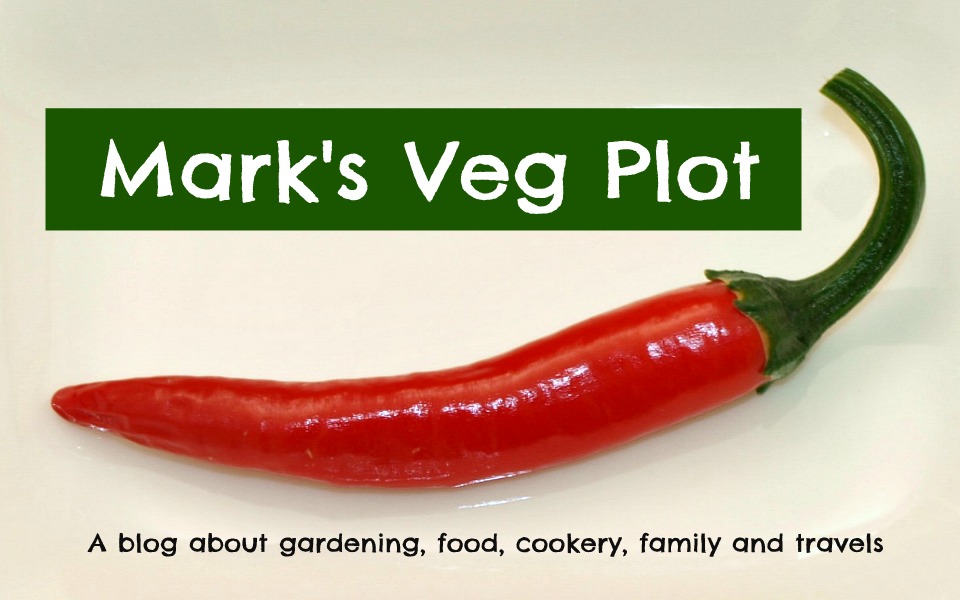At the weekend I erected this net over my cabbages. It is supported by flexible plastic hoops, and pegged to the soil with wire staples.
I also made this "quarantine area" for my PSB seedlings, which are awaiting their turn to be planted (which will come when the Broad Beans are finished). It consists of the frame of one of my mini-greenhouses with some netting draped over the top and held in place with clothes-pegs. It doesn't need to be anything fancy, because it only has to last a week or ten days.
Elsewhere, the Blueberries are also protected by a net. You can see that the berries are colouring-up as they ripen, and I'm sure that the Blackbirds will have noticed this too! Without netting, these berries would disappear very rapidly. The Blackbirds are less fussy than we humans are, and will often pinch berries that are very under-ripe by our standards, so that they can get in before us.
Then of course there are the Brussels Sprouts:
And the Carrots and Parsnips. Will those Parsnips ever stop getting taller??? It was only the other day I raised their Enviromesh cover by about two feet, and now it looks as if I need to do it again! It's a good job I bought a huge piece of mesh.
These days I don't think I would manage to get a viable crop of anything if I didn't have nets. It makes me wonder what I did before I had them, since it is only relatively recently that I started using them. I suppose in the "old days" I would have been less demanding, and perhaps happier with a small (and often damaged) crop.

Very allotment-esque. All you can see on allotment sites at this time of year is netting.
ReplyDeleteNetting is getting to be required here too. I spent a bit on sunday squashing cabbage fly catapiller. Fortunately the blueberries remain undiscovered. But we've a much bigger pest to content with. A raccon has discovered the garden and cause some destruction last night. Not sure a net will help.
ReplyDeleteYour garden is still beautiful...even will all the netting :)
ReplyDeleteLike you my garden has a lot of row covers on the crops. Cabbages, carrots, turnips, chard. Even my zucchini for a short time. I hate the ones that you can't see through, but I don't mind the other ones as much.
ReplyDeleteVery necessary yes, as I learnt to great cost last year with my brassica massacre!
ReplyDeleteEverything looks perfect. Unfortunatelly (let's say so), I haven't seen the white cabbage butterfly for years.
ReplyDeleteAlways necessary especially to protect brassicas. I was watching 2 cabbage white butterflies yesterday fluttering around the netting over my cabbages. After about 10 minutes one of them managed to get through the mesh. very crafty as there were no holes in the netting. I'm in the process of erecting cages around my fruit bed too, to keep the birds off.
ReplyDeleteOh yes, it's really necessary, I need to do something like this myself. When 3 years ago I had a vegetable garden for the first time - I almost had none pests around, only snails ate my decorative cabbage. But this year is horrible, there are aphids, snails, slugs and ants, I hate ants, they're making an anthill either under my cucumbers or under my thyme, I don't know how to fight them. It's like all insects around our plot learnt about our garden and they keep coming and nibble :) Next year I'll think of something.
ReplyDeleteWhat the caterpillars leave the wood pigeons will decimate.
ReplyDeleteNetting may not be as beautiful as seeing the plant without it, but it will certainly help with pests.Mark, regarding yesterday,s broad beans, I had never heard of Favas. So I looked it up and found out that broad beans, or Favas are really ancient peas. Interesting. By the way, lima beans and butter beans are entirely different in texture and creaminess. While limas are usually smaller and not as "buttery" or light colored, butter beans are softer and have a smoother texture when cooked and they taste different. Both of them are delicious. I have seen limas when cooked look a lot like your broad beans, which looked quite firm, so I always soak limas overnight or parboil them.
ReplyDelete